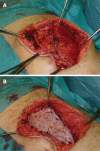Use of bovine pericardium graft for abdominal wall reconstruction in contaminated fields
- PMID: 22905285
- PMCID: PMC3420984
- DOI: 10.4240/wjgs.v4.i7.171
Use of bovine pericardium graft for abdominal wall reconstruction in contaminated fields
Abstract
Aim: To employ, in such conditions, a biological graft such as bovine pericardium that offers resistance to infection.
Methods: In our surgical department, from January 2006 to June 2010, 48 patients underwent abdominal wall reconstruction using acellular bovine pericardium; of these 34 patients had a contaminated wound due to diffuse peritonitis (complicated diverticulitis, bowel perforation, intestinal infarction, strangled hernia, etc.) and 14 patients had hernia relapse on infected synthetic mesh.
Results: In our series, one patient died of multi-organ failure 3 d after surgery. After placement of the pericardium mesh four cases of hernia relapse occurred.
Conclusion: Recurrence rate is similar to that of prosthetic mesh repair and the application of acellular bovine pericardium (Tutomesh(®), Tutogen Medical Gmbh Germany) is moreover a safe and feasible option that can be employed to manage complicated abdominal wall defects where prosthetic mesh is unsuitable.
Keywords: Abdominal hernia; Abdominal wall; Bovine pericardium; Contaminated field; hernia relapse.
Figures







References
-
- Luijendijk RW, Hop WC, van den Tol MP, de Lange DC, Braaksma MM, IJzermans JN, Boelhouwer RU, de Vries BC, Salu MK, Wereldsma JC, et al. A comparison of suture repair with mesh repair for incisional hernia. N Engl J Med. 2000;343:392–398. - PubMed
-
- Leber GE, Garb JL, Alexander AI, Reed WP. Long-term complications associated with prosthetic repair of incisional hernias. Arch Surg. 1998;133:378–382. - PubMed
-
- Jin J, Rosen MJ, Blatnik J, McGee MF, Williams CP, Marks J, Ponsky J. Use of acellular dermal matrix for complicated ventral hernia repair: does technique affect outcomes. J Am Coll Surg. 2007;205:654–660. - PubMed
-
- Morell VO, Wearden PA. Experience with bovine pericardium for the reconstruction of the aortic arch in patients undergoing a Norwood procedure. Ann Thorac Surg. 2007;84:1312–1315. - PubMed
LinkOut - more resources
Full Text Sources

